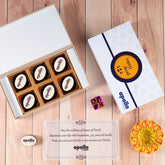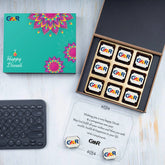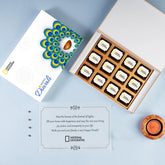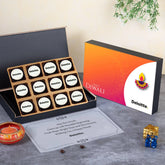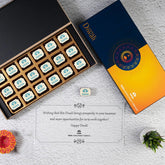From Disengaged to Delighted: Mapping the ROI Journey With Gifts
Disengaged employees are invisible drains on productivity — but a small, well-timed gesture can turn that quiet discontent into genuine delight. If you want a practical blueprint, start with how you measure and prove employee gifting ROI. That single practice shifts gifting from "nice-to-have" to strategic investment: when you treat gifts as part of an engagement funnel, they become predictable drivers of morale, retention, and advocacy.
In this guide we’ll map the journey — Awareness → Interest → Desire → Action → Advocacy — and show how employee morale gifts, especially personalised and shareable options like premium printed chocolates and keepsake boxes, can lift engagement and pay back in measurable ways. Expect facts, real-world examples, practical metrics, and a step-by-step implementation plan you can use this quarter.
------------------------------------------------------------------------------
Why gifts belong in the engagement toolkit (not the expense column)
Many companies still treat gifting as a calendar checkbox: some festival boxes in December, another batch for Diwali, maybe vouchers for top performers. Smart organisations treat gifting as part of their employee engagement funnel — an intentional sequence of moments that create emotional connection and behavioural change.
- Disengagement is expensive: global estimates show disengaged labour costs employers billions annually — making low-cost interventions high-return opportunities.
- Recognition reduces turnover: studies repeatedly show recognised employees are significantly less likely to leave — improving retention is the heart of measurable ROI.
- Gifts amplify recognition: physical, personalised gifts make recognition tangible and memorable in a way that a sentence in a meeting rarely does.
------------------------------------------------------------------------------
The engagement funnel: from awareness to advocacy
Think of gifting as a funnel with behavioural stages. Each stage has clear objectives, gift types that work best, and measurable KPIs.
1. Awareness (Disengaged → Noticed)
Objective: make people feel seen. A simple, well-branded token — a personalised chocolate pack on the first day back after leave, or a milestone note with a small keepsake — signals attention without heavy investment.
Good for: new joiners, quiet performers, remote employees.
2. Interest (Noticed → Curious)
Objective: move from a one-off notice to persistent curiosity. Shareable gifts (treats family can enjoy) and personalised messages deepen interest — employees start talking, posting, and remembering.
3. Desire (Curious → Invested)
Objective: create emotional attachment. Premium, personalised options — chocolates printed with employee photos or team milestones presented in wooden keepsake boxes — create a sense of value and belonging.
4. Action (Invested → Engaged)
Objective: translate sentiment into behaviour — higher participation in initiatives, more referrals, better punctuality or productivity. Measure this by tracking short-term productivity changes, survey upticks, and participation metrics.
5. Advocacy (Engaged → Delighted & Vocal)
Objective: delighted employees become advocates — they refer friends, amplify your EVP on social channels, and stay longer. Advocacy is the highest ROI zone because it drives lower hiring costs, higher employer brand reach, and stronger culture.
------------------------------------------------------------------------------
Why personalised, premium gifts outperform generic swag
A plain voucher or generic pen rarely creates lasting memory. Personalisation signals time, thought, and relevance — three ingredients for perceived value. In India’s increasingly premium gifting market, personalised chocolate keepsakes do two things: they create a visceral, sensory experience and they double as a keepsake (box, packaging, message).
“A gift that’s personalised is a recognition that listens.” — practical aphorism for modern HR.
Examples:
- Birthday surprise: a small printed chocolate box with the employee’s name plus a warm note — immediate goodwill.
- Onboarding welcome: a premium welcome pack on day one increases early engagement and reduces first-90-day churn risk.
- Milestone celebration: an anniversary keepsake box with team photos — turns a formal milestone into a shared memory.
------------------------------------------------------------------------------
Concrete metrics: how to measure gifting ROI in the engagement funnel
To claim full credit for gifts you must define KPIs that tie to business outcomes. Here’s a practical approach that HR & Finance can agree on.
- Baseline metrics: engagement score, voluntary turnover rate, average tenure, NPS/employee satisfaction.
- Short-term impact metrics (0–90 days): pulse survey changes after gifting campaigns; event participation rates; social mentions/internal shoutouts.
- Mid-term metrics (3–12 months): retention delta for recognised segment vs. control group; referral hires generated by recipients; productivity proxies.
- Cost metrics: total gifting spend / number of employees recognised = cost per recognition. Compare this to the cost of a single retained hire to find payback period.
Practical formula (simplified): if your cost to replace an employee is X and your gifting program reduces turnover by Y employees, ROI = (X × Y − program cost) / program cost. Many organisations find simple cases where a well-targeted gifting program delivers 2×–5× ROI through reduced hiring costs and preserved productivity.
------------------------------------------------------------------------------
Case example: Small tech firm — $0.5k spends, 3 hires retained
A mid-sized Indian tech firm ran a six-month recognition program: monthly personalised treats for top contributors and milestone keepsakes for 25% of staff. Program cost: ₹400,000 over 6 months. Replacement cost per mid-level engineer: ₹800,000. They measured 3 prevented voluntary exits in that cohort. Payback = (₹800,000 × 3 − ₹400,000) / ₹400,000 = 5× ROI. Anecdotally, internal survey scores rose 12% in recognised segments.
------------------------------------------------------------------------------
Best practices: how to design a gifting funnel that actually works
Use these tips to design low-friction, high-impact gifting programs:
- Segment your audience: not every employee needs the same gift. Tailor by seniority, role, and life stage.
- Mix surprise with planned recognition: occasional surprise treats + scheduled milestone gifts keep attention and predictability.
- Offer choice: when possible, give recipients options (flavour, delivery time, family-friendly variants) — ownership increases appreciation.
- Make it shareable: shareable, edible gifts have higher social spread; family-inclusive packaging extends goodwill outside the office.
- Capture signal data: a simple post-gift pulse survey or QR code that links to a thank-you page helps measure sentiment and track engagement. (See our guide on how to track post-gift engagement.)
- Document the story: photos, quotes, and short testimonials build qualitative proof for leadership reviews.
------------------------------------------------------------------------------
Integrating gifts into HR workflows (practical playbook)
Embed gifting in existing processes to avoid operational friction:
- Plan calendar moments: onboarding, anniversaries, festivals, performance recognitions.
- Define triggers: completion of training, NPS > X, manager nomination, peer votes.
- Choose vendors & packaging: prioritise quality and repeatability — keepsake options and printed personalisation increase perceived value.
- Log & measure: track send date, recipient, cost, and follow-up sentiment in your HRIS or a simple spreadsheet.
- Report monthly: show leadership engagement trends and ROI-metrics in the HR dashboard. For calculating expected returns see our employee gifting ROI calculator guide.
------------------------------------------------------------------------------
Real-world product cues — how ChocoCraft fits the funnel
ChocoCraft’s range of personalised printed chocolates and keepsake boxes is a practical fit for each stage of the funnel. Small personalised packs are perfect for Awareness and Interest phases, whereas premium wooden keepsake boxes with printed photos or branded messaging belong to the Desire and Advocacy stages.
- 2-chocolate box (10 boxes) — ideal for quick recognition touchpoints.
- 6-chocolate box — great for birthdays and small wins.
- 12-chocolate box — for milestone celebrations and team treats.
- 18-chocolate box — for leadership gifting and client appreciation.
------------------------------------------------------------------------------
Budgeting: finding the sweet spot between premium and practical
Your gifting budget should align to deal size and retention impact. For most mid-market teams in India, a tiered approach works best: low-cost but meaningful items for the broader team (₹200–₹700 per person) and premium preserved keepsakes for critical moments or high-impact employees (₹1,000–₹5,000).
Read more on choosing the right value per deal in our breakdown on the premium vs budget employee gifts blog.
------------------------------------------------------------------------------
Tax, compliance and Indian nuances
In India, gifting programs must be designed with tax rules and corporate policy in mind. Small items and festival gifts often fall under different tax treatments than higher-value rewards — so consult your finance team. For an actionable primer on tax-efficient gifting under ₹5,000, see our guide on tax-efficient employee gifting.
------------------------------------------------------------------------------
Common objections — and how to answer them
Here are pushbacks you’ll hear and suggested responses backed by data and practice:
- “Gifts are expensive.”
- Compare the program cost to replacement and hiring expenses. A few prevented exits will often pay for the program. Use the ROI calculator to show the math in leadership meetings (see our ROI calculator post).
- “Employees prefer cash or vouchers.”
- Choice matters — offer options when possible. Research shows many employees value personalised, shareable gifts as much as vouchers because of the emotional element and memory value.
- “How do we avoid favoritism?”
- Set clear criteria and rotate recognition. Combine manager-nominated awards with peer recognition to broaden coverage.
------------------------------------------------------------------------------
Implementation checklist (30–60 day sprint)
Launch a minimal viable gifting program in 30–60 days with this checklist:
- Define objectives & success metrics (retention delta, engagement uplift)
- Choose vendor(s) — prioritise fulfilment capacity and personalisation options
- Design tiered catalog (everyday touch, milestone box, premium keepsake)
- Set triggers and calendar events; test with a pilot team
- Collect feedback, iterate, and report results
------------------------------------------------------------------------------
Data & research snippets to strengthen your business case
Use these credible touchpoints when you present to leadership:
- Market growth: The corporate gifting and personalised gifting markets are expanding rapidly across APAC — signalling vendor maturity and acceptance of premium gifting. (Statista)
- Engagement impact: Recognised employees are significantly less likely to leave — making recognition a retention lever. (SHRM / recognition research summaries.) (SHRM)
- Culture ROI: Thought leadership on recognition programs highlights improved morale, productivity, and candidate attraction. (Forbes)
- Practical playbooks: Industry groups and culture conferences provide frameworks to measure recognition ROI and embed programs into HR operations. (CultureCon)
- Implementation evidence: Vendor and HR case studies show multiple organisations achieve multi-fold ROI from targeted gifting campaigns. (Gartner / Forrester summaries)
------------------------------------------------------------------------------
Content & social proof: make gifts tell a story
Don’t bury your wins in spreadsheets. Capture photos (with consent), employee quotes, and short videos. These assets turn gifting into content for recruitment, PR, and internal comms. If employees share on social channels, make it easy: include a branded hashtag and encourage a short caption — the organic reach from genuine posts amplifies ROI in unexpected ways.
For ideas on turning post-gift engagement into measurable signals, check our article on tracking post-gift engagement.
------------------------------------------------------------------------------
Ten tactical gift ideas mapped to funnel stages
- Microsurprise packs — single printed chocolates for day-one recognition (Awareness).
- Birthday keepsakes — personalised 6-box sets for birthdays (Interest).
- Milestone wooden boxes — printed photos and messages for anniversaries (Desire).
- Team celebration hampers — 12–18 box hampers for team wins (Action).
- Referral thank-you gifts — premium boxes for successful hires (Advocacy).
- Festival packages — Diwali & New Year premium box collections for families (Awareness → Interest).
- Wellness treat packs — sugar-free or dark-chocolate options for wellbeing-focused employees (Interest).
- On-the-spot appreciation packs — small packs managers can give during standups (Awareness).
- Client appreciation bundles — branded sets for B2B client-touchpoints (Advocacy & Brand).
- Custom-branded leadership gifts — high-end boxes for exec recognition (Desire).
------------------------------------------------------------------------------
Where to start: pilot plan for HR and leadership
Start with a 90-day pilot focusing on one team or office. Keep the pilot simple: nominate recognition triggers, choose one personalised product (for example, our popular 6- or 12-box options), measure sentiment changes and any shifts in short-term retention indicators. Share pilot results with the leadership team along with qualitative testimonials.
For product selection and bulk packaging options, browse our corporate gifting pages: Corporate Gift for Employees, Corporate Gifts, and festival collections like Corporate Diwali Gifts and New Year & Christmas Gifts.
------------------------------------------------------------------------------
Additional in-depth resources
These internal posts provide deeper playbooks that pair with this guide:
- Personalised vs Generic Employee Gifts — Better ROI
- Timely Employee Gifts — Productivity Boost Data
- Premium vs Budget Employee Gifts — ROI Sweet Spot
- Psychology of Appreciation — Gifts vs Verbal Praise
- Tiered Gifting Strategy
- Measuring Long-Term Brand Advocacy
- Track Post-Gift Engagement
- Calculate ROI on Employee Gifts (Indian Guide)
- ROI Calculator — Forecast 2026
- Tax Efficient Employee Gifting (India)
------------------------------------------------------------------------------
Vendor selection checklist — what to ask before you buy
When choosing a gifting vendor, ask these:
- Can you personalise at scale (names, photos, messages)?
- What are fulfillment lead times for 50–5,000 units?
- Do you provide sample packs and creative mockups?
- Are there eco-friendly packaging options?
- Do you support multi-city shipping and payroll integration for ordering?
------------------------------------------------------------------------------
Closing the loop: reporting and continuous improvement
Once your program runs, close the feedback loop: present engagement and retention deltas in monthly HR reports, capture employee testimonials, measure referral rates from recipients, and test different product tiers. Continuous iteration ensures gifts remain relevant and ROI stays visible.
------------------------------------------------------------------------------
Final thoughts — a CEO-level case for gifting
Leaders often ask for a crisp rationale: why invest in gifting rather than bonuses or other benefits? The answer lies in memory and momentum. Gifts create moments that build culture; culture reduces voluntary exits and increases productivity. When you map gifts into an engagement funnel, define KPIs, and pilot with measurable outcomes, gifting becomes a low-risk, high-reward lever for retention, employer brand, and recruitment.
If you’re ready to pilot, start small, instrument everything, and treat results like a product: test, measure, iterate. For hands-on help with product selection, packaging options, or customised quotes, explore our corporate catalogue pages: Corporate Gifts for Customers and the main Corporate Gifts page.
------------------------------------------------------------------------------
Ready to move your team from disengaged to delighted?
If you’re an HR leader, marketing head, admin manager or CEO ready to pilot a gifting funnel this quarter, we can help you design the pilot, choose the right products, and build an ROI dashboard. Start by exploring curated packs:
Or request a corporate consultation and sample pack from ChocoCraft today — get started here. Small investments in thoughtful recognition deliver big returns — and your next delighted advocate might just be one personalised box away.
------------------------------------------------------------------------------
Key Takeaways
-
Gifting isn’t just an expense—when mapped to the engagement funnel, it’s a strategic investment in employee morale and productivity.
-
Personalisation is the differentiator—customised gifts foster stronger emotional bonds and higher retention.
-
Tracking ROI matters—surveys, performance data, and engagement metrics help quantify the impact.
-
Cultural alignment boosts relevance—festival or milestone-based gifts create stronger connections.
-
Long-term gains outweigh short-term costs—loyal employees contribute more consistently to organisational success.
------------------------------------------------------------------------------
Key Information
| Aspect | Details | Impact on ROI |
|---|---|---|
| Gift Type | Personalised, high-quality gifts like logo-printed chocolates | Enhances emotional connection & brand recall |
| Engagement Funnel Stage | Awareness → Interest → Participation → Advocacy | Smooth transition from disengaged to engaged employee |
| Morale Boosting Factor | Thoughtful gifts acknowledging employee efforts | Improves job satisfaction and retention |
| Cultural Relevance | Festival-specific gifting (e.g., Diwali, Holi) | Aligns with employee values & traditions |
| Tracking ROI | Use surveys, feedback forms, and engagement metrics | Measures tangible and intangible returns |
| Budget Allocation | Tiered gifting strategy based on employee contribution | Maximises impact within budget constraints |
| Long-Term Effect | Higher loyalty, lower turnover, stronger employer brand | Sustained ROI over time |
| Emotional Value | Memories linked to personalised keepsakes | Increases emotional attachment to company |
------------------------------------------------------------------------------
FAQs
-
Why is employee gifting important for ROI?
Employee gifting builds morale, strengthens emotional connections, and increases retention. When gifts are personalised and thoughtful, they act as a long-term investment, boosting productivity and brand loyalty, ultimately leading to a measurable return on investment. -
How does personalised corporate gifting improve employee engagement?
Personalised gifts—like logo-printed chocolates—show employees they are valued as individuals. This creates a stronger emotional connection, increasing motivation, engagement, and brand advocacy, which directly contributes to higher ROI. -
What’s the best way to measure employee gifting ROI?
Track ROI through employee surveys, retention rates, engagement scores, and productivity improvements. Analysing these metrics shows whether your gifting program is delivering both tangible and intangible benefits. -
Is festival-based gifting more effective than regular gifts?
Yes, festival-based gifting, such as Diwali chocolates, resonates more because it aligns with cultural values. It’s timely, memorable, and leaves a positive emotional imprint, enhancing both brand recall and loyalty. -
Should all employees get the same gift?
Not necessarily. A tiered gifting strategy—based on contribution or role—ensures your budget delivers maximum impact while keeping gifts thoughtful and personalised for different employee segments. -
How do corporate gifts impact long-term loyalty?
Consistent, meaningful gifts create positive memories linked to your brand. This fosters loyalty, reduces turnover, and transforms employees into long-term advocates for your company. -
What’s the ideal budget for corporate Diwali gifts?
The ideal budget depends on company size and goals. For best ROI, align gift value with employee contribution and ensure gifts are high-quality, culturally relevant, and personalised. -
Do branded chocolates really improve brand recall?
Absolutely. Branded chocolates are a sensory gift—employees remember the taste, design, and occasion. This multi-sensory recall makes your brand more memorable compared to generic corporate swag. -
How can I track the effectiveness of my gifting campaign?
Use QR codes, feedback forms, and engagement tracking tools. This helps you see how employees respond, and whether your gifts are influencing engagement and performance metrics. -
What mistakes should I avoid in employee gifting?
Avoid overly generic gifts, poor timing, or ignoring cultural relevance. Also, not tracking ROI is a common pitfall—without measurement, you can’t improve your strategy.
